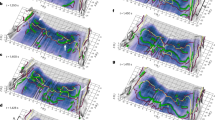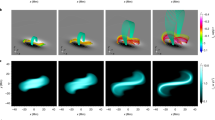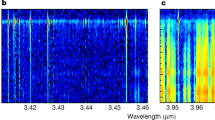Abstract
Planetary magnetic fields control energetic particles in their space environments and guide particles to polar atmospheres, where they produce stunning auroral forms. As revealed by spacecraft measurements of the Earth, Saturn and Jupiter, the pathways of energetic particles to these planetary polar atmospheres are diverse, suggesting that there are different coupling processes between their ionospheres and magnetospheres. These planets all have dipole-dominated magnetic fields, rotate in the same direction and are blown by the solar wind, but what controls the global-scale patterns of energy dissipation remains unknown. Based on three-dimensional magnetohydrodynamics calculations, we reveal that the competition between planet-driven plasma rotation and solar-wind-driven flow convection determines the structure of global auroral morphologies. This unified theoretical framework can reproduce polar aurora from the Earth-type to the Jupiter-type based on transition states that are strikingly consistent with the highly variable aurora patterns of Saturn. This generalized description of fundamental magnetospheric physics, proposed here and validated by decades-long observations, is applicable to exoplanetary systems.
This is a preview of subscription content, access via your institution
Access options
Access Nature and 54 other Nature Portfolio journals
Get Nature+, our best-value online-access subscription
$29.99 / 30 days
cancel any time
Subscribe to this journal
Receive 12 digital issues and online access to articles
$119.00 per year
only $9.92 per issue
Buy this article
- Purchase on Springer Link
- Instant access to full article PDF
Prices may be subject to local taxes which are calculated during checkout



Similar content being viewed by others
Data availability
The IMAGE FUV/WIC data, the UDF software for IMAGE data installation and FUVIEW3 for display were obtained from http://sprg.ssl.berkeley.edu/image/. The Hubble Space Telescope observations of Saturn’s aurorae were obtained from https://archive.stsci.edu/hst/search.php, and the Jovian auroral image is archived in NASA’s Planetary Data System (http://pds-atmospheres.nmsu.edu/data_and_services/atmospheres_data/JUNO/juno.html).
Code availability
The simulation data and source code are available upon request.
References
Jones, C. A. Planetary magnetic fields and fluid dynamos. Annu. Rev. Fluid Mech. 43, 583–614 (2011).
Hallinan, G. et al. Magnetospherically driven optical and radio aurorae at the end of the stellar main sequence. Nature 523, 568–571 (2015).
Kao, M. M., Hallinan, G., Pineda, J. S., Stevenson, D. & Burgasser, A. The strongest magnetic fields on the coolest brown dwarfs. Astrophys. J. Suppl. Ser. 237, 25 (2018).
Stevenson, D. J. Interiors of the giant planets. Annu. Rev. Earth Planet. Sci. 10, 257 (1982).
Stevenson, D. J. Planetary magnetic fields. Earth Planet. Sci. Lett. 208, 1–11 (2003).
Guillot, T. The interiors of giant planets: models and outstanding questions. Annu. Rev. Earth Planet. Sci. 33, 493–530 (2005).
Schubert, G. & Soderlund, K. M. Planetary magnetic fields: observations and models. Phys. Earth Planet. Inter. 187, 92–108 (2011).
Liu, S., Kong, D. & Yan, J. Possible approach to detecting the mysterious Saturnian convective dynamo through gravitational sounding. Astron. Astrophys. 644, A48 (2020).
Boakes, P. D. et al. On the use of IMAGE FUV for estimating the latitude of the open/closed magnetic field line boundary in the ionosphere. Ann. Geophys. 26, 2759–2769 (2008).
Imber, S. M., Milan, S. E. & Hubert, B. The auroral and ionospheric flow signatures of dual lobe reconnection. Ann. Geophys. 24, 3115–3129 (2006).
Fear, R. C. & Milan, S. E. The IMF dependence of the local time of transpolar arcs: implications for formation mechanism. J. Geophys. Res.: Space Phys. https://doi.org/10.1029/2011JA017209 (2012).
Milan, S. E., Lester, M., Cowley, S. W. H. & Brittnacher, M. Dayside convection and auroral morphology during an interval of northward interplanetary magnetic field. Ann. Geophys. 18, 436–444 (2000).
Milan, S. E., Provan, G. & Hubert, B. Magnetic flux transport in the Dungey cycle: a survey of dayside and nightside reconnection rates. J. Geophys. Res.: Space Phys. https://doi.org/10.1029/2006JA011642 (2007).
Wing, S., Gkioulidou, M., Johnson, J. R., Newell, P. T. & Wang, C.-P. Auroral particle precipitation characterized by the substorm cycle. J. Geophys. Res.: Space Phys. 118, 1022–1039 (2013).
Hardy, D. A., Gussenhoven, M. S. & Holeman, E. A statistical model of auroral electron precipitation. J. Geophys. Res.: Space Phys. 90, 4229–4248 (1985).
Sandel, B. R. & Broadfoot, A. L. Morphology of Saturn’s aurora. Nature 292, 679–682 (1981).
Clarke, J. T. et al. in Jupiter. The Planet, Satellites and Magnetosphere, Vol. 1 (eds Bagenal, F. et al.) 639–670 (Cambridge Univ. Press, 2004).
Eather, R. H. & Mende, S. B. Airborne observations of auroral precipitation patterns. J. Geophys. Res. 76, 1746–1755 (1971).
Eather, R. H. Auroral proton precipitation and hydrogen emissions. Rev. Geophys. 5, 207–285 (1967).
Gérard, J.-C. et al. Saturn’s auroral morphology and activity during quiet magnetospheric conditions. J. Geophys. Res.: Space Phys. 111, A12210 (2006).
Grodent, D., Gérard, J.-C., Cowley, S. W. H., Bunce, E. J. & Clarke, J. T. Variable morphology of Saturn’s southern ultraviolet aurora. J. Geophys. Res.: Space Phys. 110, A07215 (2005).
Carbary, J. F. The morphology of Saturn’s ultraviolet aurora. J. Geophys. Res.: Space Phys. 117, A06210 (2012).
Clarke, J. T. in Auroral Phenomenology and Magnetospheric Processes: Earth and Other Planets (eds Keiling, A. et al.) 113–122 (AGU, 2012).
Greathouse, T. et al. Local time dependence of Jupiter’s polar auroral emissions observed by Juno UVS. J. Geophys. Res.: Planets 126, e2021JE006954 (2021).
Sulaiman, A. H. et al. Jupiter’s low-altitude auroral zones: fields, particles, plasma waves, and density depletions. J. Geophys. Res.: Space Phys. 127, e2022JA030334 (2022).
Hill, T. W. in Solar-Terrestrial Physics: Principles and Theoretical Foundations (eds R. L. Carovillano & J. M. Forbes) 261–302 (Springer, 1983).
Borovsky, J. E. The rudiments of a theory of solar wind/magnetosphere coupling derived from first principles. J. Geophys. Res.: Space Phys. https://doi.org/10.1029/2007JA012646 (2008).
Isbell, J., Dessler, A. J. & Waite, J. H. Jr. Magnetospheric energization by interaction between planetary spin and the solar wind. J. Geophys. Res.: Space Phys. 89, 10716–10722 (1984).
Chappell, C. R., Moore, T. E. & Waite, J. H. Jr The ionosphere as a fully adequate source of plasma for the Earth’s magnetosphere. J. Geophys. Res.: Space Phys. 92, 5896–5910 (1987).
Delamere, P. A. et al. Solar wind and internally driven dynamics: influences on magnetodiscs and auroral responses. Space Sci. Rev. 187, 51–97 (2015).
Russell, C. T. The solar wind interaction with the Earth’s magnetosphere: a tutorial. IEEE Trans. Plasma Sci. 28, 1818–1830 (2000).
McComas, D. J. & Bagenal, F. Jupiter: a fundamentally different magnetospheric interaction with the solar wind. Geophys. Res. Lett. https://doi.org/10.1029/2007GL031078 (2007).
Cowley, S. W. H. et al. Reconnection in a rotation-dominated magnetosphere and its relation to Saturn’s auroral dynamics. J. Geophys. Res.: Space Phys. https://doi.org/10.1029/2004JA010796 (2005).
Leboeuf, J. N., Tajima, T., Kennel, C. F. & Dawson, J. M. Global simulation of the time-dependent magnetosphere. Geophys. Res. Lett. 5, 609–612 (1978).
Lyon, J. G., Brecht, S. H., Huba, J. D., Fedder, J. A. & Palmadesso, P. J. Computer simulation of a geomagnetic substorm. Phys. Rev. Lett. 46, 1038–1041 (1981).
Raeder, J., Berchem, J. & Ashour-Abdalla, M. The geospace environment modeling grand challenge: results from a global geospace circulation model. J. Geophys. Res.: Space Phys. 103, 14787–14797 (1998).
Tanaka, T. The state transition model of the substorm onset. J. Geophys. Res.: Space Phys. 105, 21081–21096 (2000).
White, W. et al. in Space Weather (eds Song. P. et al.) 229–240 (AGU, 2001).
Hu, Y. Q., Guo, X. C. & Wang, C. On the ionospheric and reconnection potentials of the Earth: results from global MHD simulations. J. Geophys. Res.: Space Phys. https://doi.org/10.1029/2006JA012145 (2007).
Janhunen, P., Koskinen, K. & Pulkinen, T. A new global ionosphere–magnetosphere coupling simulation utilizing locally varying time step. In Proc. International Conference on Substorms (eds Rolfe, E. J. and Kaldeich, B.) 205–210 (ESA, 1996).
Zhang, B., Lotko, W., Brambles, O., Wiltberger, M. & Lyon, J. Electron precipitation models in global magnetosphere simulations. J. Geophys. Res.: Space Phys. 120, 1035–1056 (2015).
Choe, J. Y., Beard, D. B. & Sullivan, E. C. Precise calculation of the magnetosphere surface for a tilted dipole. Planet. Space Sci. 21, 485–498 (1973).
Spreiter, J. R. & Alksne, A. Y. Plasma flow around the magnetosphere. Rev. Geophys. 7, 11–50 (1969).
Joy, S. P. et al. Probabilistic models of the Jovian magnetopause and bow shock locations. J. Geophys. Res.: Space Phys. 107, 1309 (2002).
Zhang, B. et al. How Jupiter’s unusual magnetospheric topology structures its aurora. Sci. Adv. 7, eabd1204 (2021).
Yao, Z. et al. Revealing the source of Jupiter’s X-ray auroral flares. Sci. Adv. 7, eabf0851 (2021).
Keiling, A., Wygant, J. R., Cattell, C. A., Mozer, F. S. & Russell, C. T. The global morphology of wave Poynting flux: powering the aurora. Science 299, 383–386 (2003).
Keiling, A. The dynamics of the Alfvénic oval. J. Atmos. Sol.-Terr. Phys. 219, 105616 (2021).
Zhang, B. et al. Magnetotail origins of auroral Alfvénic power. J. Geophys. Res.: Space Phys. https://doi.org/10.1029/2012JA017680 (2012).
Ebert, R., Bagenal, F., McComas, D. & Fowler, C. A survey of solar wind conditions at 5 au: a tool for interpreting solar wind-magnetosphere interactions at Jupiter. Front. Astron. Space Sci. 1, 4 (2014).
Echer, E. Solar wind and interplanetary shock parameters near Saturn’s orbit (∼10 au). Planet. Space Sci. 165, 210–220 (2019).
Merkin, V. G. et al. Global MHD simulations of the strongly driven magnetosphere: modeling of the transpolar potential saturation. J. Geophys. Res.: Space Phys. https://doi.org/10.1029/2004JA010993 (2005).
Siscoe, G., Raeder, J. & Ridley, A. J. Transpolar potential saturation models compared. J. Geophys. Res.: Space Phys. https://doi.org/10.1029/2003JA010318 (2004).
Hill, T. W. Inertial limit on corotation. J. Geophys. Res.: Space Phys. 84, 6554–6558 (1979).
Zhang, B. et al. How does mass loading impact local versus global control on dayside reconnection? Geophys. Res. Lett. 43, 1837–1844 (2016).
Salveter, A., Saur, J., Clark, G. & Mauk, B. H. Jovian auroral electron precipitation budget—a statistical analysis of diffuse, mono-energetic, and broadband auroral electron distributions. J. Geophys. Res.: Space Phys. 127, e2021JA030224 (2022).
Zhang, B. Z. et al. GAMERA: a three-dimensional finite-volume MHD solver for non-orthogonal curvilinear geometries. Astrophys. J. Suppl. Ser. 244, 35 (2019).
Brambles, O. J. et al. Magnetosphere sawtooth oscillations induced by ionospheric outflow. Science 332, 1183–1186 (2011).
Wiltberger, M., Lotko, W., Lyon, J. G., Damiano, P. & Merkin, V. Influence of cusp O+ outflow on magnetotail dynamics in a multifluid MHD model of the magnetosphere. J. Geophys. Res.: Space Phys. 115, 7 (2010).
Lyon, J. G., Fedder, J. A. & Mobarry, C. M. The Lyon–Fedder–Mobarry (LFM) global MHD magnetospheric simulation code. J. Atmos. Sol.-Terr. Phys. 66, 1333–1350 (2004).
Ouellette, J. E., Rogers, B. N., Wiltberger, M. & Lyon, J. G. Magnetic reconnection at the dayside magnetopause in global Lyon–Fedder–Mobarry simulations. J. Geophys. Res.: Space Phys. 115, A08222 (2010).
Zhang, B. et al. Transition from global to local control of dayside reconnection from ionospheric-sourced mass loading. J. Geophys. Res.: Space Phys. 122, 9474–9488 (2017).
Zhang, B., Brambles, O. J., Lotko, W. & Lyon, J. G. Is nightside outflow required to induce magnetospheric sawtooth oscillations. Geophys. Res. Lett. 47, e2019GL086419 (2020).
Baumjohann, W. & Treumann, R. Basic Space Plasma Physics (World Scientific, 1996).
Burke, W. J., Weimer, D. R. & Maynard, N. C. Geoeffective interplanetary scale sizes derived from regression analysis of polar cap potentials. J. Geophys. Res.: Space Phys. 104, 9989–9994 (1999).
Spreiter, J. R., Summers, A. L. & Alksne, A. Y. Hydromagnetic flow around the magnetosphere. Planet. Space Sci. 14, 223–253 (1966).
Bagenal, F. & Delamere, P. A. Flow of mass and energy in the magnetospheres of Jupiter and Saturn. J. Geophys. Res.: Space Phys. https://doi.org/10.1029/2010JA016294 (2011).
Smith, H. T. et al. Enceladus plume variability and the neutral gas densities in Saturn’s magnetosphere. J. Geophys. Res.: Space Phys. https://doi.org/10.1029/2009JA015184 (2010).
Lopez, R. E. The integrated dayside merging rate is controlled primarily by the solar wind. J. Geophys. Res.: Space Phys. 121, 4435–4445 (2016).
Guo, R. L. et al. A rotating azimuthally distributed auroral current system on Saturn revealed by the Cassini spacecraft. Astrophys. J. Lett. 919, L25 (2021).
Mauk, B. H. et al. in Saturn from Cassini-Huygens (eds Dougherty, M. K. et al.) 281–331 (Springer, 2009).
Palmaerts, B. et al. A long-lasting auroral spiral rotating around Saturn’s pole. Geophys. Res. Lett. 47, e2020GL088810 (2020).
Hue, V. et al. Detection and characterization of circular expanding UV-emissions observed in Jupiter’s polar auroral regions. J. Geophys. Res.: Space Phys. 126, e2020JA028971 (2021).
Acknowledgements
This work is supported by the Excellent Young Scientists Fund (Hong Kong and Macau) of the National Natural Science Foundation of China (Grant Nos. 41922060, 42074211 and 42374212) and Research Grants Council (RGC) General Research Fund (Grant Nos. 17308221, 17308520, 17315222 and 17308723).
Author information
Authors and Affiliations
Contributions
B.Z. and Z. Y designed the numerical experiment and led the conceptual framework to understand the uniform auroral picture. O.J.B., J.C., K.A.S. and V.G.M. developed the numerical code. P.A.D., W.L. and J.G.L. provided crucial insights in the theoretical investigations. D.G. and B.B. processed the auroral images. All authors participated in producing the manuscript and revisions.
Corresponding author
Ethics declarations
Competing interests
The authors declare no competing interests.
Peer review
Peer review information
Nature Astronomy thanks Robert Lysak and the other, anonymous, reviewer(s) for their contribution to the peer review of this work.
Additional information
Publisher’s note Springer Nature remains neutral with regard to jurisdictional claims in published maps and institutional affiliations.
Supplementary information
Supplementary Information
Supplementary Figs. 1–8.
Rights and permissions
Springer Nature or its licensor (e.g. a society or other partner) holds exclusive rights to this article under a publishing agreement with the author(s) or other rightsholder(s); author self-archiving of the accepted manuscript version of this article is solely governed by the terms of such publishing agreement and applicable law.
About this article
Cite this article
Zhang, B., Yao, Z., Brambles, O.J. et al. A unified framework for global auroral morphologies of different planets. Nat Astron (2024). https://doi.org/10.1038/s41550-024-02270-3
Received:
Accepted:
Published:
DOI: https://doi.org/10.1038/s41550-024-02270-3



